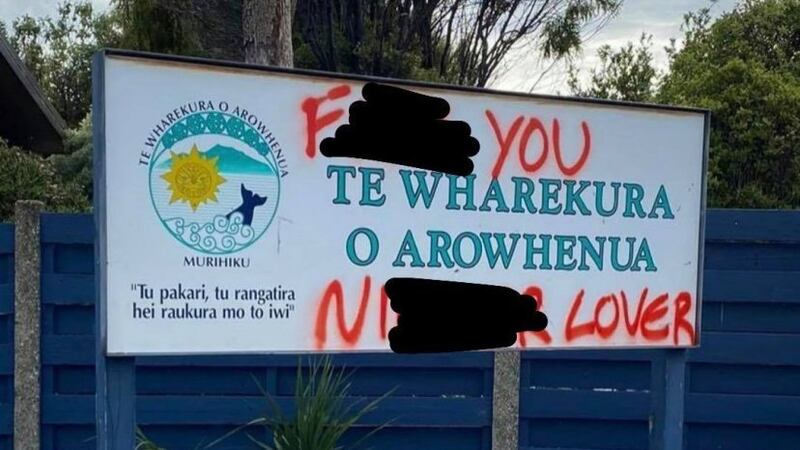He kupu kanga, he kupu kaikiri anō hoki kua tuhia ki te tohu a Te Wharekura o Arowhenua, me te tū hoki o ngā pihi o te whānau.
Nō te ahipō o te Tūrei a Ne'kol Hura, he raukura, he kaiako hoki nō te kura Aho Matua nei, ka whakairi i tētahi karere ki te Pukamata.
"Ko tōku kura tēnei, ko te manawa o Te Aho Matua i te whaitua nei kua tāhawahawatia katoatia e tētahi pokokōhua kūare."
E kitea ana tētahi whakaahua o te tohu a te kura kua takakinotia e ngā kupu "F**k you" me te "N****r Lovers".
Kaore i te mōhiotia nā wāi te hara nei, nā te aha hoki i pēnei ai.
Ahakoa tana pouri, e rere ana te whakapātaritari a Hura ki ngā raukura o Te Aho Matua, otirā, ki te motu whānui, kia kaha te tāmi i tēnei wairua kino e horapa ana i te motu whānui.
"Kei aku raukura, kei aku kahukura o tō tātou kura, kia kaha tātou ki te kōrero Māori ahakoa ki hea tātou haere ai i te tāone nei. Kia kaha tātou ki te whakatairanga i tō tātou Māoritanga kia kitea ai e te marea, e te tini ngerongero tōna rerehua."
Nō te tau 1990 Te Wharekura o Arowhenua ka oroko-tīmatahia mai. I taua wā, tōna 35 noaiho ngā tauira, engari, kua tipu ki tōna 160 mai i te tau 1 ki te tau 13.
Koia te kaipupuri i te mauri o Te Aho Matua ki Murihiku. Ko tētahi o ngā Kura Kaupapa Māori e rima o te waipounamu.
Read full post here:
HE MEA TŪTURU TE KAIKIRITANGA KI AOTEAROA, EHARA I TE KŌRERO NOA IHO!
Here is the ugly face of racism right here in the deep south of Waihōpai, Invercargill. Ko tōku kura tēnei, ko te manawa o Te Aho Matua i te whaitua nei kua tāhawahawatia katoatia e tētahi pokokōhua kūare.
Kei aku raukura, kei aku kahukura o tō tātou kura, kia kaha tātou ki te kōrero Māori ahakoa ki hea tātou haere ai i te tāone nei. Kia kaha tātou ki te whakatairanga i tō tātou Māoritanga kia kitea ai e te marea, e te tini ngerongero tōna rerehua.
Let's normalise te reo Māori here in the South and represent our iwi and tūpuna no matter what! Let's get comfortable in the discomfort of the awkward conversations that need to take place with Pākehā living here on Kai Tahu whenua. Let's educate them on how we became the minority here in Southland, and let us educate in love and compassion rather than anger and hate.
The signing of the Treaty made it easier for settlers to acquire land. While many of them only mixed socially with other settlers, some male colonists consolidated their position by marrying Māori Kai Tahu women and accessing land as whānau or kin. These Pākehā were often key ‘go-betweens’, connecting settlers and Māori. At the same time, the children of Māori and Pākeha settlers were defined as ‘half casts’ and white settlers often saw themselves and their culture or ‘civilisation’ as superior to Māori culture. Racism, the belief that some people were superior to others on the basis of their ethnic origins, existed alongside recognition in the Treaty of Māori as British citizens and official encouragement of marriage between Māori and settlers.
Dodgy and unjust land sales here in Te Waipounamu took place from 1844 to 1863 in a series of nine purchases. The largest of these was the Canterbury purchase of 1848, negotiated by Henry Tacy Kemp, which saw 20 million acres (about 8 million hectares) sold for £2,000. The other principal transaction was the Otago purchase of 1844: 400,000 acres (about 162,000 hectares)sold for £2,400.
"In a racist society it is not enough to be non-racist. We must be anti-racist".
I have a dream that one day my son and nieces can walk down Esk Street conversing in te reo Māori and bump into another reo Māori speaking whānau. I also have a dream that one day when I am out 'n about doing my shopping in town, and greet a Pākehā kaimahi with a "Kiaora", it will be returned. Mā te aha i te moemoeā!

